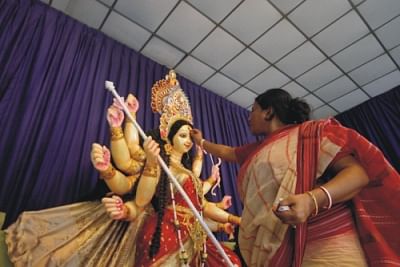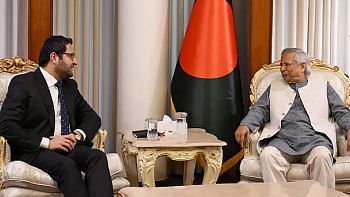Durga Puja: Its religious and social meaning

One mother to another. Photo: Munir Uz Zaman/ Drik News
DURGA Puja is the festival of promp and power, the greatest socio-religious extravaganza of the Bengali Hindus -- is now a celebration witnessed in almost all the major cities of the world. It is a mixture of spiritual sublimity and an enlivened sociability that gives it a multi-dimensional excellence.
The exquisite beauty of the Pratima (icon), splendidly adorned in colourful devotional outfit, adds additional grandeur to the whole spectrum of jubilation and enlightenment. Bengali culture and Bengali literature owe a lot to this socio-cultural fanfare and nostalgic articulations.
Driven away by Demon King Mahishasura, who became invincible by dint of heavenly boon, celestial gods and goddesses with their king Indra were roaming about in the wilderness and deliberating on ways to regain their lost fortunes. They approached Projapati Brahma to tide over their vicissitudes by defeating Mahishasura. Brahma led the celestial gods and goddesses to Lord Vishnu, who was in deep self-absorption at that time, for mitigating their sufferings.
Hearing the wails and entreaties of the gods and goddess, Lord Vishnu woke up from His slumber and told them that Mahishasura could not be destroyed by any male and, as such, only an extraordinary, devastating female manifestation was capable of doing the job. God Vishnu advised the celestial gods and goddesses to endow the emerging image with the best of their powers and clout and to invoke Her blessings for vanquishing Demon King Mahishasura.
Out of the flames that came out from the mouths of the gods and goddesses, and the cumulative power delivered by them, there emerged a female image with scintillating radiance and overflowing passion for annihilating the adversary.
She is Divine Mother Durga -- the manifestation of infinite power of the universe and the symbol of feminine majesty. It is this Devi Durga who destroyed Mahishasura as an embodiment of triumph of the right over the wrong, thereby steadying the unsettled equilibrium of the disturbed worldly order.
The Hindus believe Goddess Durga is the Divine Mother since Her grace is boundless, Her compassion unlimited, Her knowledge infallible, Her power immeasurable, Her glory ineffable and Her splendour indescribable. She offers material prosperity and spiritual sublimity to the worshippers. This is possibly the reason for the adoration of Goddess Durga by the Bengali Hindus the world over.
Devi Durga is an incarnation of the all-pervading and all-powerful entity designed by Lord Vishnu, the absolute and supreme entity regulating the entire universe. She is an embodiment of the highest purity, serenity and sublimity, and an endearing symbol of beauty, power, excellence, compassion, benediction, affluence and all that is great and good.
The story of the origin of worshipping of Goddess Durga is submerged in obscurity. While some religious pundits say that Goddess Durga has been worshipped since before the dawn of recorded history, others say that Raja Surath and Baisya Samadhi introduced Durga Puja in its present form about 2000 years ago.
Deprived of power and wealth, Raja Surath and Baisya Samathi moved around in the wilderness in search of ways to regain their lost fortunes and ultimately met Maharishi Medhosh and sought his blessings to get over their vicissitudes. Following his advice, they worshipped Goddess Durga with due solemnity and devotion and recovered their lost fortunes.
Celestial gods and goddesses on numerous occasions invoked Devi Durga's help to withstand the onslaughts of demons and devil incarnates. She came to be known as "Mashishsuramardini" as she annihilated mighty demon King Mahishashura. Durga Puja, celebrated during the autumn, is called Akal Bodhan as this part of the year is considered inauspicious for any religious performance. Lord Rama invoked the blessings of Goddess Durga in autumn for destroying demon King Ravana. This is why Durga Puja, celebrated in the month of Aswin, is called Akal Bodhan.
The social and economic significance of Durga Puja can hardly be exaggerated. It involves the services of potters, craftsmen, drummers, painters, blacksmiths, gardeners, cleaners, decorators, up to the high priests. Durga Puja generates brisk economic activities for a large number of people, especially in the rural areas, for a large part of the year.
In the past, the rural economy of Bengal revolved round Durga Puja, which was usually celebrated by the affluent people. But, with the lapse of time, the landed aristocracy disappeared from the scene and the emerging rich shifted to towns and cities, leaving the countryside to its fate.
Hinduism cannot be traced to any specific starting point in history, and it does not have a founder, nor is it based on a particular "holy book" as the basis of spiritual guidance. It is, in fact, the cumulative realisation of the Supreme Truth by the "Debarshis," "Rajarshis" and the highly developed spiritual personalities of the world that act as the driving spirit of Hinduism.
Of necessity, it is universal in character and magnanimous in content. The Vedas, the Upanishadas and the Bhagwat Gita are, no doubt, sacred texts of the Hindus, but they go beyond them in search of the Ultimate Reality. The Hindus believe that the entire cosmos is subject to the vicissitudes of time and, consequently, whatever has an origin at a point of time has an inevitable end.
The process of creation (Shristy) and dissolution (Pralaya) of the universe is a periodic cycle, in which the entire cosmos manifests at the time of creation and withdraws at the time of dissolution. Everything but the Infinite is conditioned by time. The process continues till the liberation of the soul from the cycle of birth and death is attained.
The Ultimate Reality is spoken of as the Indestructible, the Supreme Being, the Almighty etc. From this we get a clear idea to the question of cycle of life and death, the nature of the soul, the Universe and the Creator, the unity of the creation and reasons for joys and sufferings and the ultimate understanding of man's relationships with God.
Hinduism believes in the unison of the creation. It is built upon diversity and holds within itself an amazing, even bewildering, variety of teachers and teachings from the most primitive forms to the most abstract spiritual philosophies and practices. It has always remained open to new teachings and revelations on the one hand and yet has not cut itself off from the older tradition on the other.
Adaptability to properly handle the emerging global diversity of human beings, and the diverse cultures and inhibitions, is a part of the Hindu way of looking at and doing things. A pluralistic religious view visualises that there are many religions and religious paths and they appeal to different individuals according to their varying levels of mental development, which is bound to be diverse and ever-changing.
The perplexing question is whether religions are complementary to each other and are equally true. The answer to this fractious sentiment in the religious communities lies in bigotry, each claiming to represent the only right path to God. Truth, which is the kernel of every religion, is one and the same; doctrines, however, differ considerably since they are applications of the truth by human beings under different situations.
It is thus clear that religions form a unity, and it is this unity which alone provides the right perspective of the Ultimate Truth. The various religions are merely alternative paths to the same transcendental finality. Sree Ramkrishna expoused it in a very clear and lucid manner by saying: "Jato Mat Tata Path."
The essence of religions is one and the same, i.e. to win the pleasure of the Creator. It is, therefore, imperative that humans must make sincere efforts to remove all kinds of hatred, jealousy and misunderstanding about others in the name of religion, and work hand in hand to ensure peaceful and respectful co-existence of the religions for achieving lasting peace and progress.

 For all latest news, follow The Daily Star's Google News channel.
For all latest news, follow The Daily Star's Google News channel. 



Comments